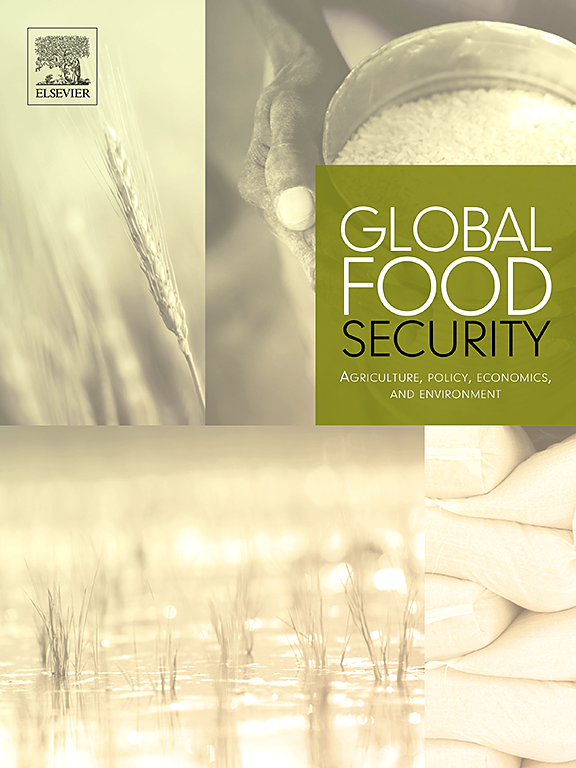探索粮食系统评估的复杂性:对框架和指标的系统文献综述
IF 9.6
1区 经济学
Q1 FOOD SCIENCE & TECHNOLOGY
Global Food Security-Agriculture Policy Economics and Environment
Pub Date : 2025-09-01
DOI:10.1016/j.gfs.2025.100881
引用次数: 0
摘要
在全球一级,评估粮食系统的势头正在增强。本研究旨在通过检查所使用的框架、维度和指标,了解如何对粮食系统进行评估。根据PRISMA的指导方针,系统的文献综述确定了40项研究,这些研究主要侧重于通过一套指标评估粮食系统或其组成部分。审查确定了12个关键重点领域,其中可持续性评估和粮食系统绩效监测是最常见的。数量有限的研究明确定义了“食物系统”的含义以及在他们的研究中如何概念化——这是大多数研究忽略的一个关键点。在使用框架的研究中,使用了两种类型——概念性和分析性。研究通常通过整合理论概念、方法方法和学科镜头来修改框架,以使其与目标和背景保持一致。用于评估粮食系统相同方面的维度的类型和数量存在显著差异。该研究编制了1096项指标,揭示了环境、社会经济和营养相关领域的倾斜分布。文献综述和参与式方法是选择和筛选指标的两种最常见的方法。与驱动因素和活动相比,与结果相关的指标占主导地位,这表明评估在很大程度上优先考虑衡量影响,而不是了解塑造粮食系统的潜在驱动因素和过程。这项研究强调了明确界定粮食系统以及明确选择框架和指标的动机和基本假设的重要性。这样做对于确保评估的一致性和提高应对复杂粮食系统挑战的知识至关重要。本文章由计算机程序翻译,如有差异,请以英文原文为准。
Exploring the complexity of food systems assessments: A systematic literature review of frameworks and indicators
There is growing momentum at the global level to assess food systems. This study aims to understand how food systems are being assessed by examining the frameworks, dimensions and indicators used. Following PRISMA guidelines, a systematic literature review identified 40 studies that primarily focused on assessing food systems or their components through a set of indicators. The review identified twelve key focus areas, of which sustainability assessments and the monitoring of food system performance were the most common. A limited number of studies explicitly defined what “food system” meant and how it was conceptualised in their study – a key point that most studies overlooked. Among the studies that used a framework, two types—conceptual and analytical—were used. Studies often modified frameworks by integrating theoretical concepts, methodological approaches, and disciplinary lenses to align with their goals and contexts. There was significant variation in the types and numbers of dimensions used to assess the same aspects of food systems. This study compiled 1096 indicators, revealing a skewed distribution towards environmental, socioeconomic, and nutrition-related domains. Literature reviews and participatory methods were the two most common approaches for selecting and shortlisting indicators. The predominance of outcome-related indicators compared to drivers and activities suggests that assessments have largely prioritised measuring impacts rather than understanding the underlying drivers and processes that shape food systems. This study highlights the importance of clearly defining food systems and being explicit about the motivations and underlying assumptions for choosing frameworks and indicators. Doing so is vital to ensure consistency in assessments and to advance knowledge for addressing complex food system challenges.
求助全文
通过发布文献求助,成功后即可免费获取论文全文。
去求助
来源期刊

Global Food Security-Agriculture Policy Economics and Environment
FOOD SCIENCE & TECHNOLOGY-
CiteScore
20.90
自引率
3.40%
发文量
69
期刊介绍:
Global Food Security plays a vital role in addressing food security challenges from local to global levels. To secure food systems, it emphasizes multifaceted actions considering technological, biophysical, institutional, economic, social, and political factors. The goal is to foster food systems that meet nutritional needs, preserve the environment, support livelihoods, tackle climate change, and diminish inequalities. This journal serves as a platform for researchers, policymakers, and practitioners to access and engage with recent, diverse research and perspectives on achieving sustainable food security globally. It aspires to be an internationally recognized resource presenting cutting-edge insights in an accessible manner to a broad audience.
 求助内容:
求助内容: 应助结果提醒方式:
应助结果提醒方式:


